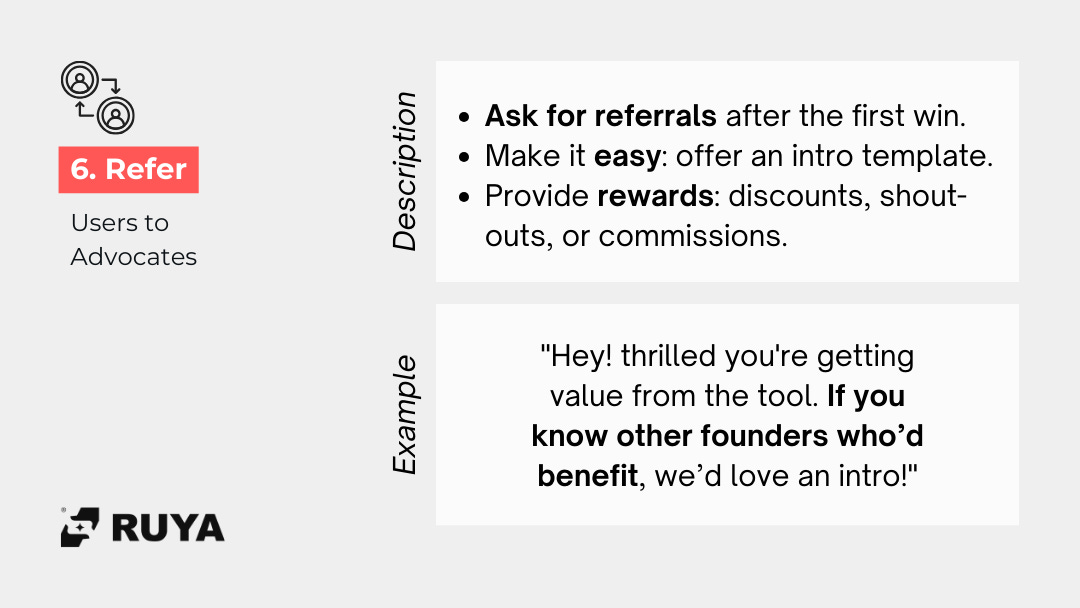How I would get my first 10 customers today (no ads).
Discover this 6 step process to get your early adopters. FAST.
In this edition:
🔷 Why relying on ads too early can create a dangerous illusion of PMF
🔷 The six-step framework to find your first 10 customers organically
🔷 Five actionable steps you can implement today to start finding customers without spending
“Here’s how I create fly wheels that acquire millions of customers while I sleep”.
Hustle bros are thriving in the AI age.
Not necessarily in their businesses, but in creating outrageous content that gets engagement from others wanting to learn the hustle as well (see above).
Should you go for this if you’re just starting?
NO.
There’s another way. And one that helps you:
(1) Validate your product
(2) Get early adopters
(3) Not burn through your entire budget on ads
And better yet? It GROWS your revenue in the right way.
When ads led me astray
After spending 10 years in digital media, I thought I knew everything about advertising.
I could build incredible campaigns, segment audiences with precision, personalize creative content, and knew exactly how to optimize for engagement, retention, and goal completion.
So naturally, when I launched my own product, I leaned heavily into what I knew best: ads.
The results looked promising at first.
Traffic flowed.
Engagement metrics ticked upward.
But something was missing, we weren’t seeing compounding growth.
That's when reality hit me: paid advertising had created an illusion of PMF.
The Problem with Starting with Ads
When you rely on paid acquisition from day one, you're putting makeup on a product … that might not be ready just yet.
Ads can mask fundamental problems with your offering, positioning, or solution fit.
More critically, you miss out on the invaluable learning process that comes from personally connecting with early customers.
Insights that can reshape your entire business strategy.
So now with early founders I work with, I share my 6 step process to getting your early adopters, fast:
A Six-Step Process to Your First 10 (or Even 100) Customers
1. Identify Your Niche
Find a specific segment with high pain points and willingness to pay that your product can genuinely address.
If you have many candidates, list potential niches and evaluate them based on these criteria until you find the right sweet spot.
2. Discover Communities
Two ways:
(1) Tap into your personal network, both direct connections and second-degree relationships.
(2) Expand your search to online communities where your potential customers gather: Reddit groups, Slack channels, Facebook groups, and specialized forums.
3. Offer Value First
Join these communities and help solve problems.
Don’t mention your product.
Answer questions, share insights, and provide valuable resources like checklists, templates, or quick guides, all for free.
Become known as a helpful expert.
4. Pitch as an Experiment
Once you've built trust with a user, don't sell, invite them to help you.
Frame your product as an experiment you're running and ask for their help and feedback.
This approach removes pressure and makes people more willing to participate.
5. Onboard with Impact
Create an onboarding process that delivers a "wow" moment as quickly as possible.
Show them immediate value to convert their curiosity into real enthusiasm.
6. Activate Referrals
Once your early users are experiencing value, make it incredibly easy for them to refer others.
Provide templates, shareable links, and incentives to turn your first customers into your best advocates.
Refine, iterate, repeat.
Until you get to your first 10 to 100 early adopters.
It’s not sexy. But it works.
Why this process is 10x compared to paid
Because this organic acquisition process isn't just about finding customers, it's about building your business.
Each interaction and conversation provides feedback on your messaging, positioning, features, and value proposition.
You’ve created a virtuous cycle where you keep learning:
Who your customer is
What their needs are
What strikes a chord with them
What isn’t appealing to them
How they perceive you
How they use your product
What turns them to advocates
These insights should flow directly back into your product and marketing strategy, creating a fantastic iteration loop.
Take Action Today
Want to start right now? Here’s your checklist:
List 3 high-pain niches you can serve. Pick one.
Write 5 names of people in your network in that niche. Reach out.
Find 3 relevant communities (Slack, Reddit, LinkedIn, etc.). Join them.
Write one helpful post or answer today. No selling.
Draft a soft invite message for early users:
“Hey, I’m working on something to solve [X]. Want early access and to help shape it?”
What’s an easy growth tip you have that anyone can benefit from?
Let’s get to work, Majd
More?
Speaking of SPEED. How to do one day validation with rapid prototyping.
Keen on AI? 6 founder use cases for ChatGPT’s new image generation tool
Structure your founder week around this blueprint for ultimate productivity
Hi, I’m Majd. I help early-stage founders build, go-to-market, and fundraise for their ventures. Here’s how I can support you:
Daily Insights: Follow me on LinkedIn for startup strategies, tips, and real-world tactics
Free Report: Try the Problem-Solution Pulse: get an 11-page personalized breakdown of your startup's foundation.
Advisory Support: Explore Ruya Advisory to see how we can work together 1:1 or through founder programs












Love a flywheel ♻️
Interesting process. But I have a question: when/where in this process do you test the willingness to pay and price sensitivity? It's not obvious to me...